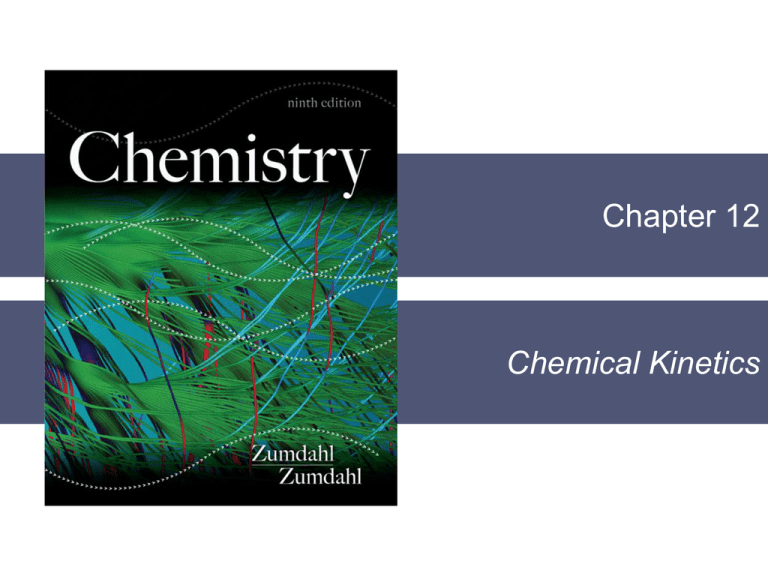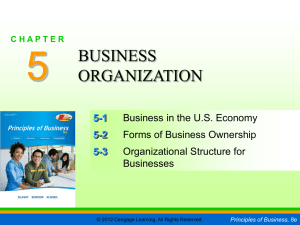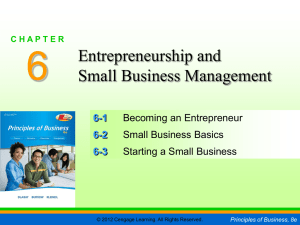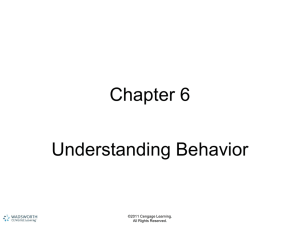
Chapter 12
Chemical Kinetics
Section 12.1
Reaction Rates
Reaction Rate
Change in concentration of a reactant or product
per unit time.
c
o
n
c
e
n
t
r
a
t
i
o
n
o
f
A
a
t
t
i
m
e
t
c
o
n
c
e
n
t
r
a
t
i
o
n
o
f
A
a
t
t
i
m
e
t
2
1
R
a
t
e
=
t
t
2
1
A
=
t
[A] means concentration of A in mol/L; A is the
reactant or product being considered.
Copyright © Cengage Learning. All rights reserved
2
Section 12.1
Reaction Rates
The Decomposition of Nitrogen Dioxide
Copyright © Cengage Learning. All rights reserved
3
Section 12.1
Reaction Rates
The Decomposition of Nitrogen Dioxide
Copyright © Cengage Learning. All rights reserved
4
Section 12.1
Reaction Rates
Instantaneous Rate
Value of the rate at a particular time.
Can be obtained by computing the slope of a line
tangent to the curve at that point.
Copyright © Cengage Learning. All rights reserved
5
Section 12.2
Rate Laws: An Introduction
Rate Law
Shows how the rate depends on the concentrations of
reactants.
For the decomposition of nitrogen dioxide:
2NO2(g) → 2NO(g) + O2(g)
Rate = k[NO2]n:
k = rate constant
n = order of the reactant
Copyright © Cengage Learning. All rights reserved
6
Section 12.2
Rate Laws: An Introduction
Rate Law
Rate = k[NO2]n
The concentrations of the products do not appear in the
rate law because the reaction rate is being studied under
conditions where the reverse reaction does not
contribute to the overall rate.
Copyright © Cengage Learning. All rights reserved
7
Section 12.2
Rate Laws: An Introduction
Rate Law
Rate = k[NO2]n
The value of the exponent n must be determined by
experiment; it cannot be written from the balanced
equation.
Copyright © Cengage Learning. All rights reserved
8
Section 12.2
Rate Laws: An Introduction
Types of Rate Laws
Differential Rate Law (rate law) – shows how the rate of
a reaction depends on concentrations.
Integrated Rate Law – shows how the concentrations of
species in the reaction depend on time.
Copyright © Cengage Learning. All rights reserved
9
Section 12.2
Rate Laws: An Introduction
Rate Laws: A Summary
Because we typically consider reactions only under
conditions where the reverse reaction is unimportant,
our rate laws will involve only concentrations of
reactants.
Because the differential and integrated rate laws for a
given reaction are related in a well–defined way, the
experimental determination of either of the rate laws is
sufficient.
Copyright © Cengage Learning. All rights reserved
10
Section 12.2
Rate Laws: An Introduction
Rate Laws: A Summary
Experimental convenience usually dictates which type of
rate law is determined experimentally.
Knowing the rate law for a reaction is important mainly
because we can usually infer the individual steps
involved in the reaction from the specific form of the
rate law.
Copyright © Cengage Learning. All rights reserved
11
Section 12.3
Determining the Form of the Rate Law
Determine experimentally the power to which each
reactant concentration must be raised in the rate law.
Copyright © Cengage Learning. All rights reserved
12
Section 12.3
Determining the Form of the Rate Law
Method of Initial Rates
The value of the initial rate is determined for each
experiment at the same value of t as close to t = 0 as
possible.
Several experiments are carried out using different initial
concentrations of each of the reactants, and the initial
rate is determined for each run.
The results are then compared to see how the initial rate
depends on the initial concentrations of each of the
reactants.
Copyright © Cengage Learning. All rights reserved
13
Section 12.3
Determining the Form of the Rate Law
Overall Reaction Order
The sum of the exponents in the reaction rate equation.
Rate = k[A]n[B]m
Overall reaction order = n + m
k = rate constant
[A] = concentration of reactant A
[B] = concentration of reactant B
Copyright © Cengage Learning. All rights reserved
14
Section 12.4
The Integrated Rate Law
First-Order
Rate = k[A]
Integrated:
ln[A] = –kt + ln[A]o
[A] = concentration of A at time t
k = rate constant
t = time
[A]o = initial concentration of A
Copyright © Cengage Learning. All rights reserved
15
Section 12.4
The Integrated Rate Law
Plot of ln[N2O5] vs Time
Copyright © Cengage Learning. All rights reserved
16
Section 12.4
The Integrated Rate Law
First-Order
Time required for a reactant to reach half its original
concentration
Half–Life:
0
.6
9
3
t1 =
2
k
k = rate constant
Half–life does not depend on the concentration of
reactants.
Copyright © Cengage Learning. All rights reserved
17
Section 12.4
The Integrated Rate Law
A first order reaction is 35% complete at the end of
55 minutes. What is the value of k?
k = 7.8 × 10–3 min–1
Copyright © Cengage Learning. All rights reserved
18
Section 12.4
The Integrated Rate Law
Second-Order
Rate = k[A]2
Integrated:
1
1
=
k
t+
A
A
0
[A] = concentration of A at time t
k = rate constant
t = time
[A]o = initial concentration of A
Copyright © Cengage Learning. All rights reserved
19
Section 12.4
The Integrated Rate Law
Plot of ln[C4H6] vs Time and Plot of 1/[C4H6] vs Time
Section 12.4
The Integrated Rate Law
Second-Order
Half–Life:
1
t1 =
2
kA
0
k = rate constant
[A]o = initial concentration of A
Half–life gets longer as the reaction progresses and the
concentration of reactants decrease.
Each successive half–life is double the preceding one.
Copyright © Cengage Learning. All rights reserved
21
Section 12.4
The Integrated Rate Law
EXERCISE!
For a reaction aA Products,
[A]0 = 5.0 M, and the first two half-lives are 25 and 50
minutes, respectively.
a) Write the rate law for this reaction.
rate = k[A]2
b) Calculate k.
k = 8.0 × 10-3 M–1min–1
a) Calculate [A] at t = 525 minutes.
[A] = 0.23 M
Copyright © Cengage Learning. All rights reserved
22
Section 12.4
The Integrated Rate Law
Zero-Order
Rate = k[A]0 = k
Integrated:
[A] = –kt + [A]o
[A] = concentration of A at time t
k = rate constant
t = time
[A]o = initial concentration of A
Copyright © Cengage Learning. All rights reserved
23
Section 12.4
The Integrated Rate Law
Plot of [A] vs Time
Copyright © Cengage Learning. All rights reserved
24
Section 12.4
The Integrated Rate Law
Zero-Order
Half–Life:
A0
t1 =
2
2k
k = rate constant
[A]o = initial concentration of A
Half–life gets shorter as the reaction progresses and the
concentration of reactants decrease.
Copyright © Cengage Learning. All rights reserved
25
Section 12.4
The Integrated Rate Law
CONCEPT CHECK!
How can you tell the difference among 0th, 1st, and 2nd
order rate laws from their graphs?
Copyright © Cengage Learning. All rights reserved
26
Section 12.4
The Integrated Rate Law
Summary of the Rate Laws
Copyright © Cengage Learning. All rights reserved
27
Section 12.4
The Integrated Rate Law
EXERCISE!
Consider the reaction aA Products.
[A]0 = 5.0 M and k = 1.0 × 10–2 (assume the units are appropriate
for each case). Calculate [A] after 30.0 seconds have passed,
assuming the reaction is:
a) Zero order
b) First order
c) Second order
Copyright © Cengage Learning. All rights reserved
4.7 M
3.7 M
2.0 M
28
Section 12.5
Reaction Mechanisms
Reaction Mechanism
Most chemical reactions occur by a series of elementary
steps.
An intermediate is formed in one step and used up in a
subsequent step and thus is never seen as a product in
the overall balanced reaction.
Copyright © Cengage Learning. All rights reserved
29
Section 12.5
Reaction Mechanisms
A Molecular Representation of the Elementary Steps in the Reaction
of NO2 and CO
NO2(g) + CO(g) → NO(g) + CO2(g)
Copyright © Cengage Learning. All rights reserved
30
Section 12.5
Reaction Mechanisms
Elementary Steps (Molecularity)
Unimolecular – reaction involving one molecule; first
order.
Bimolecular – reaction involving the collision of two
species; second order.
Termolecular – reaction involving the collision of three
species; third order. Very rare.
Copyright © Cengage Learning. All rights reserved
31
Section 12.5
Reaction Mechanisms
Rate-Determining Step
A reaction is only as fast as its slowest step.
The rate-determining step (slowest step) determines the
rate law and the molecularity of the overall reaction.
Copyright © Cengage Learning. All rights reserved
32
Section 12.5
Reaction Mechanisms
Reaction Mechanism Requirements
The sum of the elementary steps must give the overall
balanced equation for the reaction.
The mechanism must agree with the experimentally
determined rate law.
Copyright © Cengage Learning. All rights reserved
33
Section 12.5
Reaction Mechanisms
Decomposition of N2O5
2N2O5(g) 4NO2(g) + O2(g)
Step 1: 2(N2O5
NO2 + NO3 )
Step 2: NO2 + NO3 → NO + O2 + NO2
Step 3: NO3 + NO → 2NO2
Copyright © Cengage Learning. All rights reserved
(fast)
(slow)
(fast)
34
Section 12.5
Reaction Mechanisms
CONCEPT CHECK!
The reaction A + 2B C has the following proposed
mechanism:
A+B
D
(fast equilibrium)
D+BC
(slow)
Write the rate law for this mechanism.
rate = k[A][B]2
Copyright © Cengage Learning. All rights reserved
35
Section 12.6
A Model for Chemical Kinetics
Collision Model
Molecules must collide to react.
Main Factors:
Activation energy, Ea
Temperature
Molecular orientations
Copyright © Cengage Learning. All rights reserved
36
Section 12.6
A Model for Chemical Kinetics
Activation Energy, Ea
Energy that must be overcome to produce a chemical
reaction.
Copyright © Cengage Learning. All rights reserved
37
Section 12.6
A Model for Chemical Kinetics
Change in Potential Energy
Copyright © Cengage Learning. All rights reserved
38
Section 12.6
A Model for Chemical Kinetics
For Reactants to Form Products
Collision must involve enough energy to produce the
reaction (must equal or exceed the activation energy).
Relative orientation of the reactants must allow
formation of any new bonds necessary to produce
products.
Copyright © Cengage Learning. All rights reserved
39
Section 12.6
A Model for Chemical Kinetics
Arrhenius Equation
E
/
R
T
a
k
=
A
e
A
Ea
R
T
=
=
=
=
Copyright © Cengage Learning. All rights reserved
frequency factor
activation energy
gas constant (8.3145 J/K·mol)
temperature (in K)
40
Section 12.6
A Model for Chemical Kinetics
Linear Form of Arrhenius Equation
E
1
a
l
n
(
k
)
=
+
l
n
A
R
T
Copyright © Cengage Learning. All rights reserved
41
Section 12.6
A Model for Chemical Kinetics
Linear Form of Arrhenius Equation
Copyright © Cengage Learning. All rights reserved
42
Section 12.6
A Model for Chemical Kinetics
EXERCISE!
Chemists commonly use a rule of thumb that an
increase of 10 K in temperature doubles the rate of a
reaction. What must the activation energy be for this
statement to be true for a temperature increase from
25°C to 35°C?
Ea = 53 kJ
Copyright © Cengage Learning. All rights reserved
43
Section 12.7
Catalysis
Catalyst
A substance that speeds up a reaction without being
consumed itself.
Provides a new pathway for the reaction with a lower
activation energy.
Copyright © Cengage Learning. All rights reserved
44
Section 12.7
Catalysis
Energy Plots for a Catalyzed and an Uncatalyzed Pathway for
a Given Reaction
Copyright © Cengage Learning. All rights reserved
45
Section 12.7
Catalysis
Effect of a Catalyst on the Number of Reaction-Producing
Collisions
Copyright © Cengage Learning. All rights reserved
46
Section 12.7
Catalysis
Heterogeneous Catalyst
Most often involves gaseous reactants being adsorbed
on the surface of a solid catalyst.
Adsorption – collection of one substance on the surface
of another substance.
Copyright © Cengage Learning. All rights reserved
47
Section 12.7
Catalysis
Heterogeneous Catalyst
1.
2.
3.
4.
Adsorption and activation of the reactants.
Migration of the adsorbed reactants on the surface.
Reaction of the adsorbed substances.
Escape, or desorption, of the products.
Copyright © Cengage Learning. All rights reserved
48
Section 12.7
Catalysis
Homogeneous Catalyst
Exists in the same phase as the reacting molecules.
Enzymes are nature’s catalysts.
Copyright © Cengage Learning. All rights reserved
49








